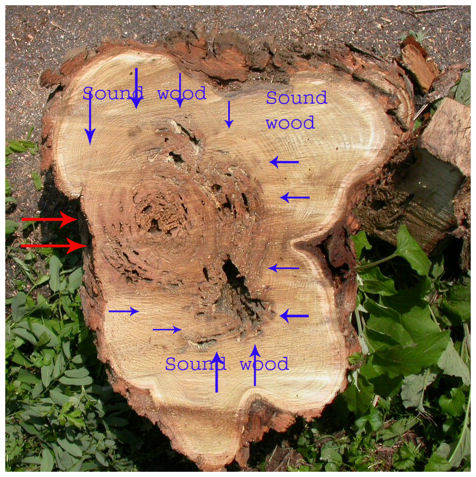

Image Source - TREES, ASSOCIATES, and SHIGO (2 CD set).
Ant Galleries and Compartmentalization - If you look closely at the cross section sample of black locust, robinia, (left) you may see the following. The red arrows show a severe wound to the tree. The blue arrows basically represent the size of the tree when the major wound occurred. A barrier zone is established separating the wood present at the time of injury and the wood that formed after the injury. (See barrier zone) The wood inside the barrier zone was altered. Then the ants came and established their galleries. The galleries in this sample respect the barrier zone and stay within the wood that was altered as a result of the wound (red arrows). As you can see, the wood outside of the barrier zone is sound. It is my understanding that the ants and their galleries seldom, if ever, move into sound wood. If you used the wood inside the barrier zone to make a 2 X 4 and used it in your house, this is where the carpenter ants will go first. Termites also respect the same boundaries of compartmentalization in wood. The problem in the building industry is they start their research by looking at the 2 x 4. You must go back to the tree to understand this succession. You will not see these boundaries in a 2 x 4. Dissecting these trees in the longitudinal plane will enhance this observation. If I get a chance I will try to dissect one for this section or see if I have a picture by Alex L. Shigo. Also the ant galleries control the environment inside the tree. They control the moisture content. Too moist or too dry stalls the decay pathogen. In this sense the ants help the tree. Ants stall decay (rot) in trees and they stall rot in building materials in your home.
Here is a white pine tree which had carpenter ants.